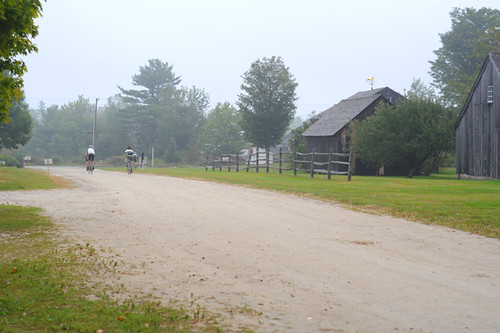
Will I ever get used to this, I wonder? These special rides, with their remote starts, carpools and road trips. I am easily excitable, and the anticipation is just too much. Once again I failed to get enough sleep the night before. The alarm clock rang at 4:30am and I went through the motions on autopilot: Shower, dress, make and drink coffee. Drag the bike outside. Gather my things and put them next to the bike. At 5:15am the van arrived and we were off. I buckled up in the back seat to keep myself from bouncing. We were becoming known as the Somerville Trio: Brian, Somervillain and myself. That morning we headed to New Hampshire, to ride the inaugural Kearsarge Klassic - a dirt road randonnee to benefit the Ausbon Sargent Land Preservation Trust. We learned of the ride just a short while earlier. "It will be like a rough, low-key version of the D2R2," somebody said. I signed up. Then I remembered that I didn't have a suitable bike.
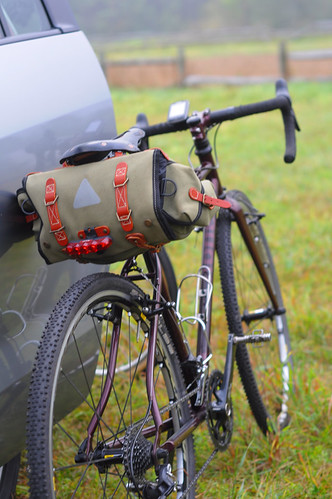
But I did have some generous friends who offered to lend me their fat-tire rides, for which I was immensely grateful. After considering my options, I borrowed the Honey cyclocross bike that I wrote about earlier. It fit me well without having to make major adjustments and I was already familiar with the handling. On the downside, the bike was geared somewhat high - good for cyclocross racing, but not for long rides with sustained climbing. I decided that a comfortable fit was more important than low gears, and accepted that I'd probably be doing some walking on this ride. I used my own saddle and attached a saddlebag.
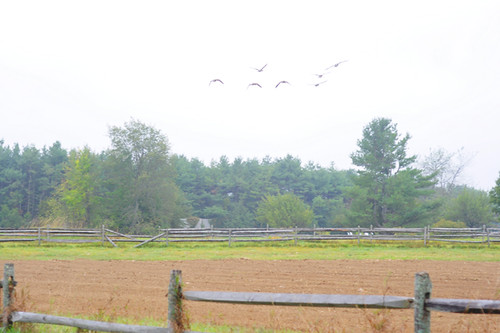
We arrived in New Hampshire just as it grew light outside. A thick fog hung over the farmlands and showed no promise of lifting. The forecast warned of "severe weather." We hoped for the best.
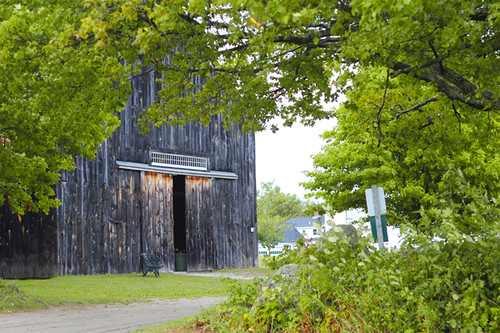
The event start was at the New London Historical Society - a small village preserved to reflect the life of rural 19th century New England. Registration was in a large unpainted barn. It was quiet. A cyclist here, a cyclist there. Three routes had been offered, and we were signed up for the Mid Circuit: 60 miles with 80% dirt and close to 5,000 feet of climbing.
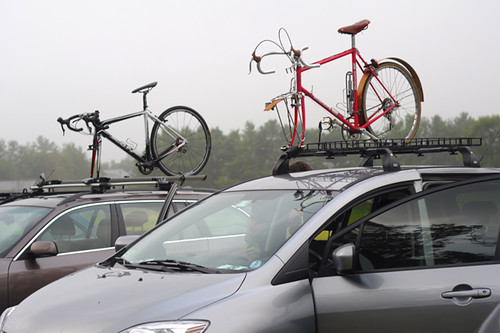
The majority of the bikes present were of the racy variety. The only classic and vintage bikes were from the handful of cyclists I already knew from back home.
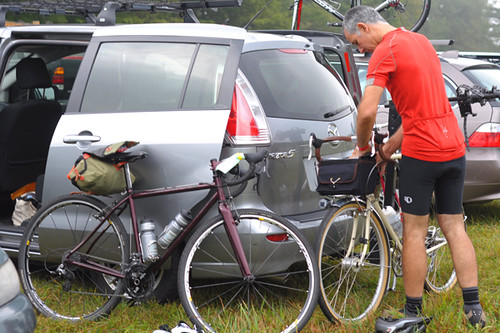
Somervillain brought his Shogunneur, which he typically rides on dirt.
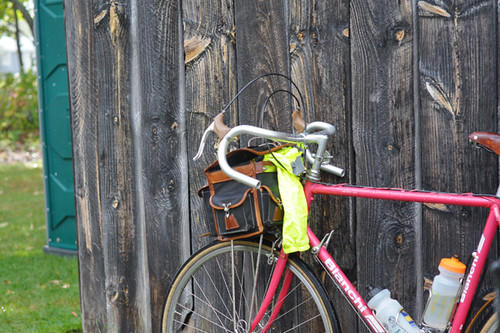
Brian brought his pink Bianchi 650B conversion, which I really must photograph and feature here soon.
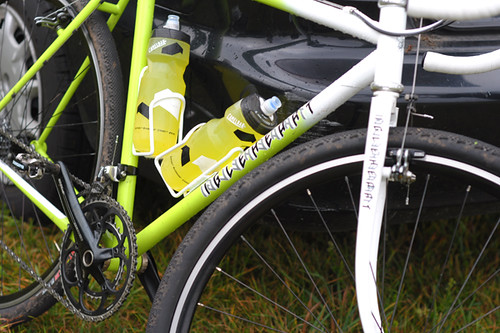
As far as handmade stuff, there was Igleheart and IF and Seven and a team on Sketchies, as well as my borrowed Honey.

But the majority were big-name racey bikes, as well as lots of Salsas and a few Somas. I saw only a couple of mountain bikes. The weapons of choice for most participants seemed to be cyclocross bikes with knobby tires or fat slicks.

Overall, participants looked serious. Lots of team kits. Circling on the grass to warm up. Not too much socialising.
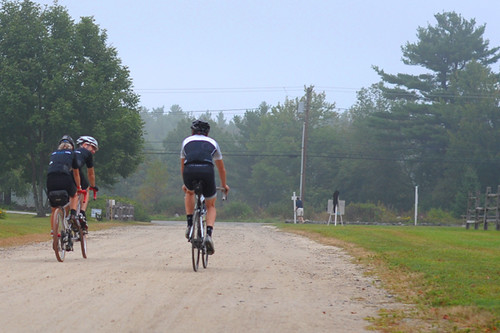
Cyclists doing the longer route had an earlier start and were taking off as we arrived. I managed to snap a picture of the Blayleys riding away on their tandem. I was sure that I'd see them again at lunch or dinner, but in fact I did not - The way the timing worked out, participants would not see much of each other in the course of the day.
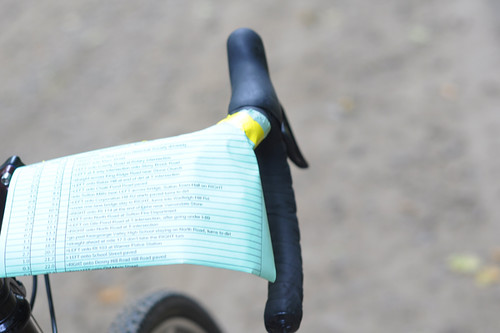
I changed into cycling shoes and secured the cue sheet to my handlebars (I will have to explain my cue sheet attachment methods in a separate post, since I know you are all dying to emulate the elegant look). The morning air was chilly, but there was also a humidity to it that suggested a hot day ahead. I wore a short sleeve wool jersey with arm warmers and stashed a rain jacket in my bag. I also had with me some food, bandaids, tools, a spare tube, sunscreen, chamois cream, insect repellent, money and of course the camera.
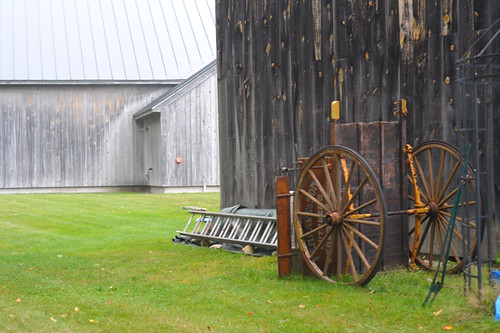
We set out just before 8am and our first destination was a rural convenience store, where we hoped to find some coffee and hot breakfast. The mission was a success and, making ourselves comfortable on the side of the road, we consumed our purchases. Just thenwe encountered Matt Roy and David Wilcox - of MM Racing and the RSC endurance team - who were about to get some food and begin as well. It was at this point that reality hit me ("These are like, really strong cyclists! What the heck am I doing here?"). But rather than dwell on it, I enjoyed my breakfast sandwich. And then we set off.
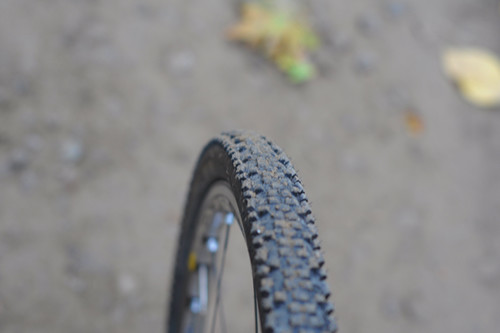
The first, paved, climb began almost immediately. And almost immediately I was cursing the bike's knobby tires and my genius idea to do this ride with a full saddlebag. As I struggled to keep up, the tires made that whoosh-whoosh-whoosh sound that wide knobbies make on pavement, as if to mock me. And then, just as I felt relief upon cresting the hill, came the steep descent. We were not even on dirt yet, but already I began to understand what this place had in store for me. And that's when I finally started to feel just a little bit nervous. As I barreled downhill toward a stop sign before a large intersection, I also recalled that my braking power on this bike was, shall we say, suboptimal. And just then the cue sheet instructed us to turn left, onto a blissfully traffic-free dirt road.

It is hard to describe the pleasure of riding for miles and miles and miles without seeing pavement. I did not really fathom what this was like until the D2R2 and the Kearsarge Klassic. I couldn't have, as we simply have nothing like this back home. Where I live on the outskirts of Boston, you have to cycle for 10-20 miles just to get to a 3-6 mile stretch of dirt - usually a trail that will be either too tame or too technical to be truly enjoyable. But here in New Hampshire, these were actual roads we were riding on that just happened to be unpaved - an entire network of roads. Winding, hilly, forested, deliciously remote. Dirt roads.It seems like a simple enough concept, but only through experience was I truly able to grasp it. All through the ride I was thinking "This is so good, so good!" I did not want it to end.
The first 8 or so miles of the ride passed serenely as we warmed up on some rolling hills and absorbed the novelty of the scenery. This was about the time I usually start to feel energetic, and with this energy I attacked the next climb, enjoying the slippedy-slidey feel of the tires on dirt.
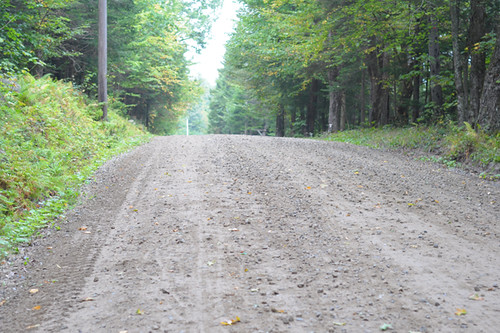
The texture of the roads varied throughout the route. Some roads were smoothly packed dirt. Others were covered with what cannot even be called gravel I don't think, but more like very large loose rocks. None of my pictures really capture this particular texture, but I am sure there is a term for it; others on the ride were talking about how rough it was. This put a damper on my fun at around mile 9, when we were faced with a steep descent on a road with this loose rocky texture. As soon as I started descending this stretch, I nearly peed in my pants from the suddenness with which the bike picked up speed while simultaneously threatening to fishtail out of control. Large stones were flying all over the place, with the bike both slicing through them and skipping off of them as I tried desperately to steer it along the winding road. I think I went into shock, so beyond my ability was this descent. When we reached a flatter section, I stopped and asked my riding partners to go on ahead of me. "Go ahead, I'll catch up to you at lunch. I'm going to be stopping to take photos." While it's true that I wanted to ride on my own for a bit and photograph the scenery, my more immediate concern at that moment was not crashing into them. If I was not confident I could control the bike, it was irresponsible to ride with others, I reasoned.
Now alone, I contemplated the descent ahead. Just then, my friend Jim and a couple of his buddies rode past, astride their shiny Sketchy bikes. They must have had a good laugh at the sight of me standing there, shell shocked from the previous descent and staring wild-eyed at the next one. "You'll be fine!" yelled Jim, and then added something about brakes. Either to use them or not to use them, or to use them in a specific way - I could not hear. I stood there for a few more minutes, until finally I just got tired of it. "Oh #@^% it," I thought, pointed the bike downhill and pushed on the pedals. My attitude at this point can best be described as "surrender." And maybe because of that, I relaxed and suddenly the bike felt as if it was not only riding itself, but teaching me how to hold my body upon it so as not to interfere with it riding itself. By the end of this, I developed an intuitive feel for how to counteract the fishtailing and how to steer around bends. It was an experience that somehow felt both calm and euphoric simultaneously. And before I knew it, it was over.
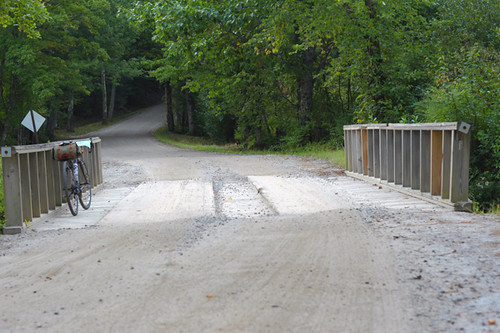
The dirt smoothed out and the long hills gave way to rollers. I followed the cue sheet along dirt road after dirt road. And then I began the killer of a climb to the first rest stop. Appropriately called Burnt Hill Road, this one mile stretch was so steep, that when I finally could not push the gears anymore and got off to walk the last bit, even the walking was tough. At the top, a meadow awaited with a picturesque view of the mountains which I forgot to photograph in the midst of talking to the rest stop volunteer. To my embarrassment, he informed me that I was the last one of the Mid Circuit group to be coming through the rest stop. I had no idea that anyone was keeping track! The description of the ride listed the times during which the stops would be open, and I was well within the limit. For me this ride was really just a photo expedition with some challenging terrain thrown in, but now I realised that more riders than not were treating it as a race. I decided to minimise my photo-stops from now on and cycle straight to lunch - which I did, albeit with a brief detour due to misunderstanding the cue sheet.
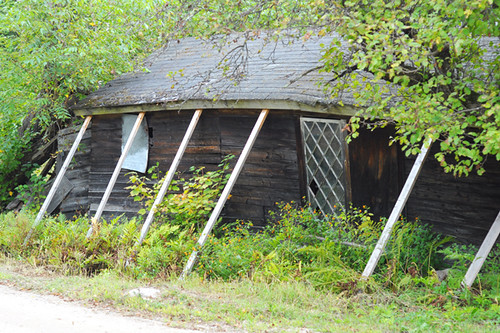
When I found the lunch stop along the main road, it was the same deal as the rest stop. It was early, but nonetheless I was last and they had already packed up. I guess I expected something similar to the D2R2, with everyone hanging out for hours before moving on. It certainly could have been like that, as we had loads of time before the event cutoff and only 20 miles to go for the Mid Circuit. I guess the timing of the various riders passing through was not in sync. But myfriends were there waiting for me, and we moved on almost as soon as I arrived to cycle the last segment of the route together.
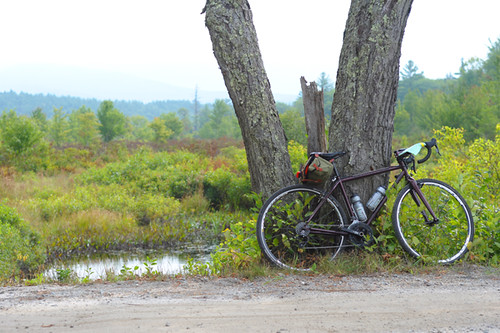
After lunch there was initially a deceptive feeling that the rest of the ride would be easy. After all, we had less than 20 miles to go. Neither of us was feeling tired after the 40 miles of the ride we'd done thus far. We enjoyed the dirt roads and discussed the scenery.New Hampshire's rural areas are noticeably different from Vermont's - less manicured, rougher, spookier. I liked that very much about this ride.
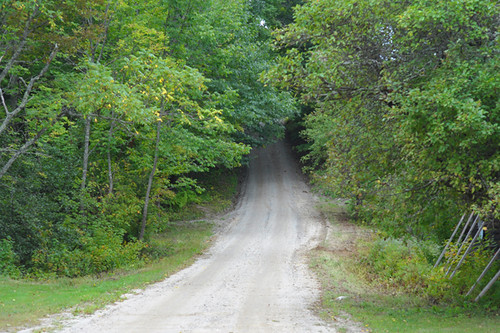
Though the day had gotten quite hot earlier, now there was a breeze and the skies were overcast - suggesting that perhaps we ought to take that "extreme weather" forecast seriously. We were doing well as far as speed until we came upon this... never-ending wall of a hill. This picture does not do it justice, since I could not possible photograph the worst of it while continuing to cycle, nor could I capture the endlessness of it. It just... kept going, at pretty much the same steep grade throughout, for several miles. I mashed for as long as I could, but did get off the bike a couple of times, unable sustain it for quite that long. Still, I made it. And upon reaching the top, we saw the indefatigable Jon Doyle and friends, on their way to the finish at the end of the longer route. We rode with them for a total of maybe 5 minutes before getting dropped on the final stretch of crazy rock-strewn descents.
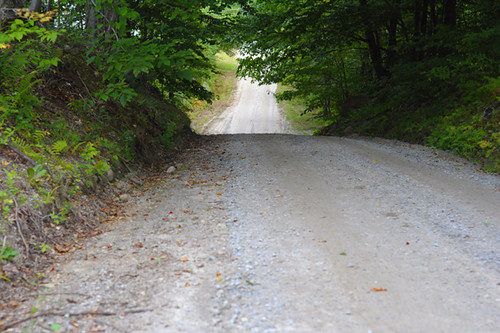
This series of descents was actually worse than what I had scared me so much at the beginning of the ride, but now I took it more calmly. In addition to the chunky loose rocks, there were washboards here - ridges over which the bike will skip wildly as the rider holds on for dear life. I got through it all, and in closer proximity to other riders this time. I felt the danger and the need to be careful, but no longer the fear. My hands did begin to hurt toward the end from modulating the brakes, but that was the extent of the damage I suffered on this ride.
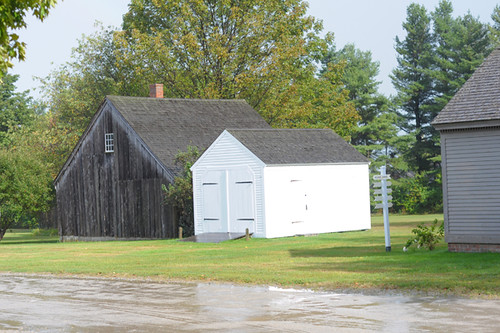
The rain held off for as long as it could, but finally came down in the very final stretch - and when it did, it did not hold back. Thankfully, by this time we were just a few miles away and completing the final paved climb toward the finish. I got off the bike to turn on my tail light and put on my rain jacket, walked the bike a bit to rest my legs, then got back on and continued to mash, bathing in cool rainwater. I rolled up to the finish euphoric and delirious - along with Brian who stayed by my side through the last rainy mashy stretch. Somervillain was under the barn's awning, off his bike and ready to snap pictures: Exhibit A and Exhibit B. There is also an "epic" shot of all three of us, resembling happy wet mice.

At the finish, the nice volunteers served five different kinds of chili and corn bread, which we gladly sampled.
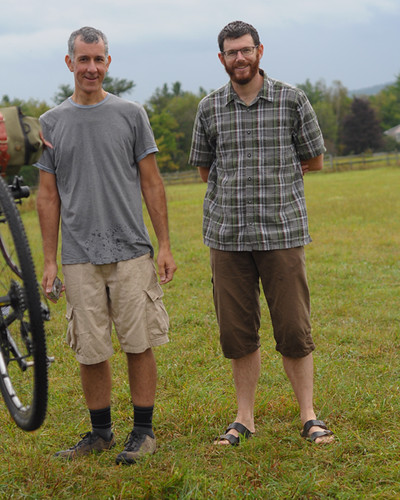
After changing into dry clothes, we took silly pictures of each other and loaded up the bikes back onto the van.We did not see many other cyclists at dinner - everyone more or less started and finished on their own timeline, had a quick dinner and left. Other cyclists were still en route and would do the same once they finished. We were a little surprised that there was not more of a social scene at the finish, but ultimately it didn't matter. The ride was fantastic.
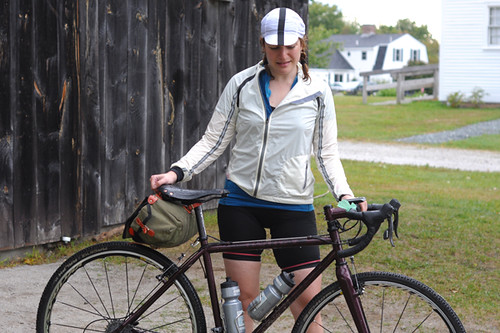
Speaking as someone relatively new to riding on dirt roads, some parts of the Kearsarge Klassic were well outside of my comfort zone. A couple of the descents were downright terrifying and overcoming that was the biggest challenge. Despite my lack of low gears, I did not mind the climbing and only had to walk a few stretches. My legs didn't feel great after all the mashing, but two days later they seem fully recovered, so all is good. I experienced no pain during or after the ride, and very little tiredness. I am grateful to have managed tocomplete the Mid-Circuit course without crashes or mishaps, and in the fine company of Brian and Somervillain.
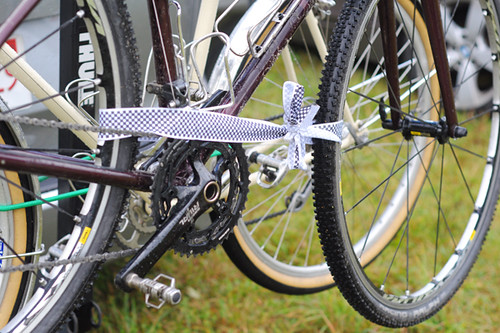
As far as bikes, I know that I've got to stop borrowing them to do these rides. So I am working on getting one of my own. Intuitive handling, wide tires and low gears is really what I'm after and there are some excellent stock options out there nowadays.
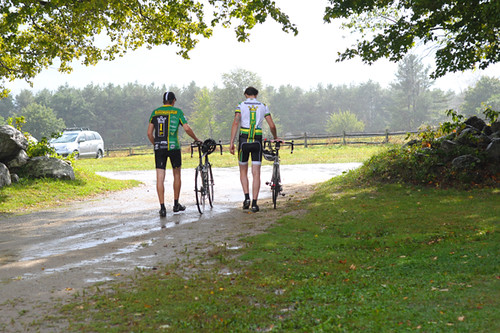
The Kearsarge Klassic is an event I would love to see develop over the years. The route was outstanding, the volunteers were wonderful, the area felt genuinely welcoming to cyclists. In comparison to the D2R2, this was a smaller and quieter event, with not so much of a festival atmosphere around it. The area is more remote, and the feel of the landscape is overall quite different. I feel very lucky indeed to have taken part in both events this summer. Many thanks to the New Hampshire Cycling Club and the Ausbon Sargent Land Preservation Trust for putting together the Kearsarge Klassic and inviting us to explore your beautiful dirt roads.
Full picture set from the event here. Also check out Somervillain's pictures here.
 Lisa has posted the Carnival of Genealogy, 52nd Edition over at 100 Years in America. The topic is "Age" and as Lisa says " This is a collection of tales and trivia, stories and statistics. Thanks to these contributions by various family historians, we have a look into the lives of others who stand out from their family tree (and society in general) because of their age." There are some new contributors as well as the "regulars" and a wide variety of tales that have been told. As always, I'm amazed at the quality and variety of the posts contributed to the COG. Check them out! Lisa has done a wonderful job of putting it all together. I for one know that it is not an easy task to come up with a good "lead" for each of the posts. Well done, Lisa!
Lisa has posted the Carnival of Genealogy, 52nd Edition over at 100 Years in America. The topic is "Age" and as Lisa says " This is a collection of tales and trivia, stories and statistics. Thanks to these contributions by various family historians, we have a look into the lives of others who stand out from their family tree (and society in general) because of their age." There are some new contributors as well as the "regulars" and a wide variety of tales that have been told. As always, I'm amazed at the quality and variety of the posts contributed to the COG. Check them out! Lisa has done a wonderful job of putting it all together. I for one know that it is not an easy task to come up with a good "lead" for each of the posts. Well done, Lisa! The next edition of the Carnival of Genealogy will be a
The next edition of the Carnival of Genealogy will be a 


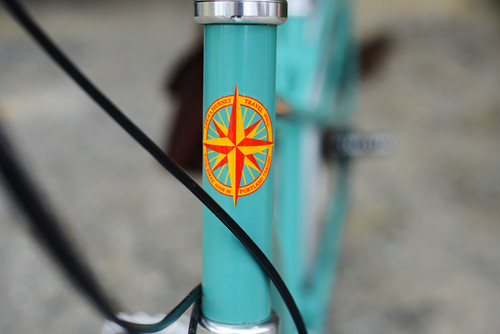





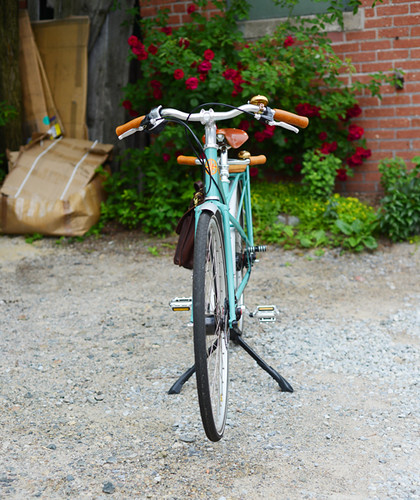
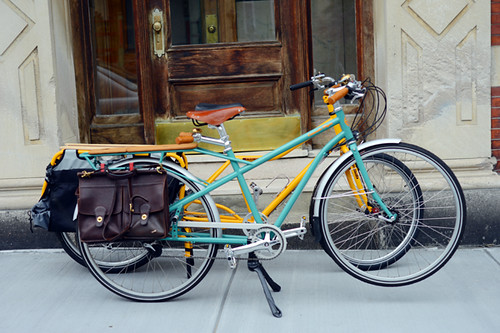
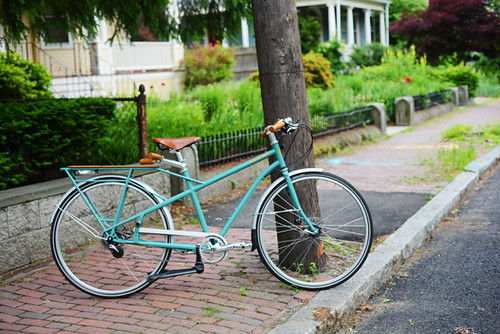
 Tri-Lakes, Indiana. July ...Copyright © .. by Rebeckah R. Wiseman.
Tri-Lakes, Indiana. July ...Copyright © .. by Rebeckah R. Wiseman. A sign at the bottom of the trail warns that even though it is short, the trail is strenuous. Some of the steps have been, quite literally, carved from the rock.
A sign at the bottom of the trail warns that even though it is short, the trail is strenuous. Some of the steps have been, quite literally, carved from the rock. Approaching the top of Moro Rock. It is a pretty safe trail with railings in place, where needed, for safety's sake. It's not scary, unless you decide to look over the edge!
Approaching the top of Moro Rock. It is a pretty safe trail with railings in place, where needed, for safety's sake. It's not scary, unless you decide to look over the edge! Plants seemed to be growing in nearly every crevice.
Plants seemed to be growing in nearly every crevice. It really wasn't dangerous, but glancing over the side and straight down did cause a bit of dizziness.
It really wasn't dangerous, but glancing over the side and straight down did cause a bit of dizziness. Looking south, toward the entrance to Sequoia National Park.
Looking south, toward the entrance to Sequoia National Park. At the top of Moro Rock.
At the top of Moro Rock. Spectacular views in every direction.
Spectacular views in every direction. Just a few of the steps that have been carved from the rock.
Just a few of the steps that have been carved from the rock.